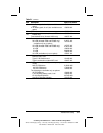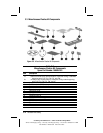
4-4 Removal and Replacement Preliminaries
COMPAQ CONFIDENTIAL - NEED TO KNOW REQUIRED
Writer: David Calvert Saved by: The Integrity Group Saved date: 10/26/00 11:46 AM
Part Number: 128679-006 File name: Ch04
4.5 Packaging and Transporting Precautions
Use the following grounding precautions when packaging and
transporting equipment:
■
To avoid hand contact, transport products in static-safe containers
such as tubes, bags, or boxes.
■
Protect all electrostatic-sensitive parts and assemblies with
conductive or approved containers or packaging.
■
Keep electrostatic-sensitive parts in their containers until they arrive
at static-free workstations.
■
Place items on a grounded surface before removing them from their
container.
■
Always be properly grounded when touching a sensitive component
or assembly.
■
Place reusable electrostatic-sensitive parts from assemblies in
protective packaging or non-conductive foam.
■
Use transporters and conveyers made of antistatic belts and roller
bushings. Ensure that mechanized equipment used for moving
materials is wired to ground, and that proper materials were selected
to avoid static charging. When grounding is not possible, use an
ionizer to dissipate electric charges.
4.6 Workstation Precautions
Use the following grounding precautions at workstations:
■
Cover the workstation with approved static-dissipative material
(refer to Table 4-2).
■
Use a wrist strap connected to a properly grounded work surface and
use properly grounded tools and equipment.
■
Use conductive field service tools, such as cutters, screwdrivers, and
vacuums.
■
When using fixtures that must directly contact dissipative surfaces,
use fixtures made of static-safe materials only.
■
Keep the work area free of nonconductive materials such as ordinary
plastic assembly aids and Styrofoam.
■
Handle electrostatic-sensitive components, parts, and assemblies by
the case or PCM laminate. Handle them only at static-free
workstations.


















